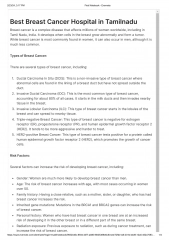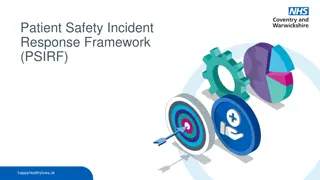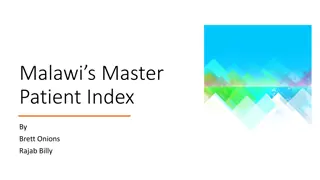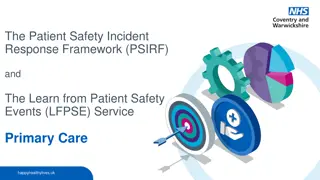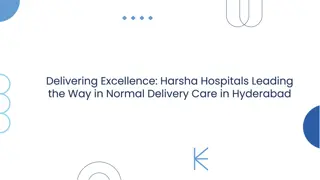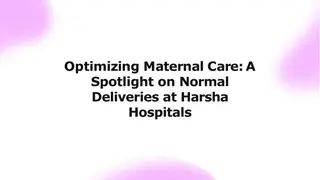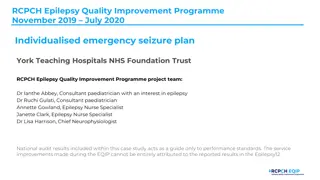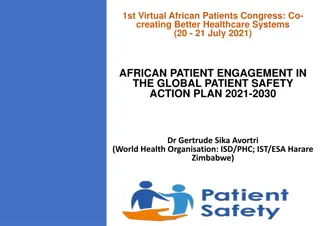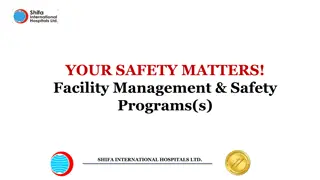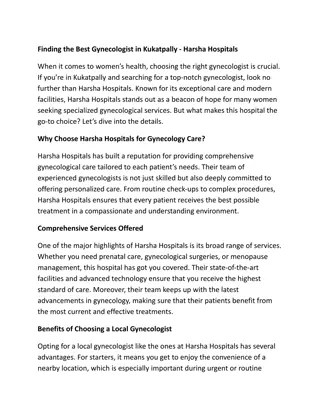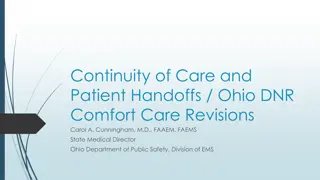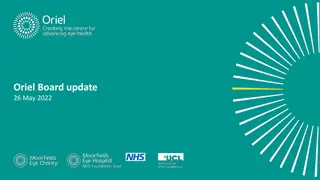Improving Patient Safety in our Hospitals
Dr. Sarah McMullen discusses the importance of early recognition and treatment of clinical deterioration in hospital settings to improve patient outcomes. Key points include identifying abnormal clinical antecedents, implementing early warning systems like NEWS2 and CHEWS, screening patients for critical care criteria, and providing resources to match patient acuity. Rapid Response Systems outside the ICU aim to prevent catastrophic deterioration through prompt and appropriate responses. International consensus groups have outlined key features for rapid response systems, emphasizing prompt activation, assessment, resourcing, and data feedback.
Download Presentation

Please find below an Image/Link to download the presentation.
The content on the website is provided AS IS for your information and personal use only. It may not be sold, licensed, or shared on other websites without obtaining consent from the author.If you encounter any issues during the download, it is possible that the publisher has removed the file from their server.
You are allowed to download the files provided on this website for personal or commercial use, subject to the condition that they are used lawfully. All files are the property of their respective owners.
The content on the website is provided AS IS for your information and personal use only. It may not be sold, licensed, or shared on other websites without obtaining consent from the author.
E N D
Presentation Transcript
Improving Patient Safety in our Hospitals Dr Sarah McMullen July 2023 *Thank you to Janice Chisholm for providing the slides
Most patients have abnormal clinical antecedents / abnormal vital signs 6-8 hrs prior to cardiac arrest Early recognition and treatment can improve outcome NS Health policies NEWS2 incoming; CHEWS (Peds) CHEWS Accreditation Canada requirements 6.1 There is a process to screen potential patients against admission criteria for critical care. 7.6 Patients and families are provided with information on how to identify when an escalation in care may be needed and how to initiate the process. 10.10 When signs of increased acuity are present, the team assesses the patient s risk and follows processes to escalate care.
Most patients display clinical evidence of deterioration 6-8 hrs before cardiac arrest In hospital cardiac arrest carries a substantial mortality: >80 % ! Early warning scores and rapid response systems seek to identify deteriorating hospitalized patients prospectively and alter their clinical trajectory through increasing the clinical resources directed to them Ie., we want to match resources to patient acuity
Rapid Response Systems Concept & Goals: Hospital Patients outside ICU Clinical stability Acute clinical decompensation Rare Catastrophic deterioration without warning Ventricular fibrillation Acute stroke Massive aspiration >80% of patients Warning signs of physiologic instability Cardiac arrest Early treatment and recovery Early, appropriate ICU transfer Delayed ICU transfer 80% mortality 70% potentially preventable Mortality by 30% Goal: Shift responses in this direction Rapid Response Systems. Topic 16280. Version 10.0 Uptodate. 2014
An international consensus group (2005) was convened to clarify designs of rapid response systems and make recommendations for their implementation Key features include: Criteria for activation 24/7 Triggering mechanism & prompt assessment Appropriately resourced team Data collection & Feedback Major goal: react promptly and appropriately to deteriorating clinical status
2005 Institutes for Healthcare Improvement (IHI) 2008 Joint Commission National Patient Safety Goals Goal 16: Improve recognition and response to changes in patient s condition In January 2005 IHI made implementation of rapid response systems a key component of the 100,000 Lives Campaign to improve the quality of care in hospitals and reduce mortality rates
Identify deteriorating hospitalized patients prospectively and seek to alter clinical trajectory through increasing clinical resources directed to them Jones et al. N Engl J Med 2011;365.139
Many studies with conflicting results Variable quality of evidence; Variable definitions Cardiac arrest rates are reduced, and there is a trend toward reduced in-hospital mortality No long-term outcomes or quality of life data available Those who have an RRT activation represent the hospital s sickest patients RRTs also facilitate ICU transfer and communication RRTs May reduce other clinical outcomes Postop complications, Respiratory failure, Stroke, Severe sepsis, Acute renal failure, Unplanned ICU transfer
Despite unclear evidence about how to best structure or implement RRS, the face validity of the concept is intuitive and strong The RRT has been described as representing the tension between needing to improve care and [not] knowing how to do it. O Horo et al., The role of the primary care team in the rapid response system. 2015. Journal of Critical Care (30): 353-357.
Disadvantages Expensive Depends on who you ask Resource intensive Regardless of who you ask RRTeam does not know the patient RRT do not address problem of patients getting the wrong level of care in the first place
There are significant concerns that RRTs decrease: the primary team s sense of responsibility/ownership trainees desire/ability to manage sick patients active primary team involvement influences RRT activation processes of care. The RRT should be an adjunct to, but not a substitute for, an engaged and present primary care team O Horo et al., The role of the primary care team in the rapid response system. 2015. Journal of Critical Care (30): 353-357.
Denver Health Medical Center developed the clinical triggers program : 4 major impediments to a quick response Failure to recognize Failure to communicate and escalate concerns Failure to physically assess the patient Failure to diagnose and treat appropriately Moldenhauer K. Joint Commision J of Qual and Patient Safety. 2004;35:3, 164.
List of clinical triggers Vitals are vital Requires face to face evaluation Structured algorithm to obtain help Empowers nurses Attending staff must be notified
9 month study period 13403 hospital discharges, 65936 hospital days 184 clinical trigger activations (146 unique patients) 3.7 activations/1000 patient discharges 2.8/1000 patient hospital days 20.4 calls per month
Cardiovascular triggers were the most common Face to face evaluation 61% of the time 9% of cases escalated to a higher level physician 12% of patients were transferred to ICU 73% of unexpected transfers to ICU had clinical triggers hours prior to transfer but did not have RRS activated For unexpected ICU transfers or cardiac arrest, 15 min time window for physician response was not an issue
Cardiopulmonary arrest rate decreased by 39% ICU bounce backs within 48hrs decreased significantly 4.62 to 3.27 / 100 transfers (p=0.03)
RRT vs Usual Care Team Combination retrospective chart review and prospective survey based evaluation Independent association with increased transfers to higher levels of care, increased code status discussions when primary service involved O'Horo JC, et al.. J Crit Care 2015; 30: 353 7 Another retrospective analysis Usual care teams lead to more transfers to ICU, more changes to resuscitation status and perceived better communication Howell MD, et al. Crit Care Med 2012; 40: 2562 68.
2011 Rapid Response Escalation Protocol introduced to VG Varying success with 3 different rollouts Why the poor uptake? Multifactorial Inadequate and inconsistent education Lack of recognition of deteriorating patients, despite escalation of care tool Limited support on all levels Lack of support for auditing
Total Escalations 135 # of transfers Floor to ICU 12 9% # of transfers Floor to IMCU 15 11% ?catching earlier and stabilizing (insufficient data to say) # of transfers IMCU to ICU 2 1.5 %
Early Warning Scores (EWS) Used by medical teams to help determine the degree of illness of a patient A simple scoring system in which a score is allocated to physiological measurements Multiple versions EWS, MEWS, NEWS, PEWS .
Systematic review 2014 Reviewed the ability of EWS to predict a patient's risk of clinical deterioration and the impact of EWS implementation on health outcomes and resource utilization CONCLUSION: EWS perform well to predict cardiac arrest and death within 48hrs Smith et al. Ann Am Thorac Soc
Housestaff must document evaluation of patient on second page Attending/on-call physician must be notified within 4 hrs of a patient meeting the criteria Attending staff must document response within 24 hrs of triggers If patient is expected to remain at a high MEWS score, then a care plan going forward must include criteria outlining when to reactivate RREP
To facilitate early recognition of patients who have the potential to deteriorate The protocol empowers frontline nursing staff to get help early It ensures that patients are actually examined It should prompt the Physicians who know the patient, to treat the patient and get help when required It will help ensure that responsible Attending staff are aware of patients who are not doing well
Recently a provincial FMEA (Failure Modes Effects Analysis) prospective review was undertaken looking at RREP from a provincial lens So while there are issues with how RREP is run, and lack of oversight and ownership, we are working on figuring this out because we recognize the importance of RREP for patient safety And, it remains an Accreditation requirement
Rationale for a standardized tool for identifying deteriorating patients: Poor results for HSMR Sepsis (one of recommendations from review) and the in-hospital sepsis indicator in multiple zones Quality reviews highlighted issues, poor patient outcomes and death High quality, safe care Consistent approach Ease of communication and transfer between levels of care OPOR will require a single tool for use in a Clinical Information System Note: Additional current tools are in use: CHEWS for pediatrics and MEWS maternity score. Consistent with IWK tools.
Rapid review on Early Warning tools by NS Health Research & Innovation Rapid review sent to physicians across province for feedback - key takeaways: support a single tool, less concerned with which tool but support a standardized scoring system; benefits of an early warning system augmented by a rapid response, importance of both for benefit NEWS2 approved as adult tool NEWS2 escalation tool Work is underway to implement NEWS2 during 2022 - 2023
Most patients have abnormal clinical antecedents / abnormal vital signs 6-8 hrs prior to cardiac arrest Early recognition and treatment can improve outcome And just makes good sense! The Rapid Response Escalation Protocol (RREP) will attempt to address this gap and improve patient safety


